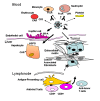Oncolytic Adenoviruses in Cancer Treatment
- PMID: 28548059
- PMCID: PMC5423481
- DOI: 10.3390/biomedicines2010036
Oncolytic Adenoviruses in Cancer Treatment
Abstract
The therapeutic use of viruses against cancer has been revived during the last two decades. Oncolytic viruses replicate and spread inside tumors, amplifying their cytotoxicity and simultaneously reversing the tumor immune suppression. Among different viruses, recombinant adenoviruses designed to replicate selectively in tumor cells have been clinically tested by intratumoral or systemic administration. Limited efficacy has been associated to poor tumor targeting, intratumoral spread, and virocentric immune responses. A deeper understanding of these three barriers will be required to design more effective oncolytic adenoviruses that, alone or combined with chemotherapy or immunotherapy, may become tools for oncologists.
Keywords: adenovirus; cancer; oncolytic; virotherapy.
Conflict of interest statement
The author declare no conflict of interest.
Figures

Similar articles
-
Oncolytic adenoviruses as a therapeutic approach for osteosarcoma: A new hope.J Bone Oncol. 2016 Dec 14;9:41-47. doi: 10.1016/j.jbo.2016.12.001. eCollection 2017 Nov. J Bone Oncol. 2016. PMID: 29226089 Free PMC article. Review.
-
Chapter four--Design of improved oncolytic adenoviruses.Adv Cancer Res. 2012;115:93-114. doi: 10.1016/B978-0-12-398342-8.00004-5. Adv Cancer Res. 2012. PMID: 23021243 Review.
-
Oncolytic adenovirus characterization: activity and immune responses.Methods Mol Biol. 2014;1089:117-32. doi: 10.1007/978-1-62703-679-5_9. Methods Mol Biol. 2014. PMID: 24132482
-
Engineering Newcastle Disease Virus as an Oncolytic Vector for Intratumoral Delivery of Immune Checkpoint Inhibitors and Immunocytokines.J Virol. 2020 Jan 17;94(3):e01677-19. doi: 10.1128/JVI.01677-19. Print 2020 Jan 17. J Virol. 2020. PMID: 31694938 Free PMC article.
-
Gene therapy targeting hepatocellular carcinoma by a dual-regulated oncolytic adenovirus harboring the focal adhesion kinase shRNA.Int J Oncol. 2015 Aug;47(2):668-78. doi: 10.3892/ijo.2015.3047. Epub 2015 Jun 12. Int J Oncol. 2015. PMID: 26081241
Cited by
-
Leading Edge: Intratumor Delivery of Monoclonal Antibodies for the Treatment of Solid Tumors.Int J Mol Sci. 2023 Jan 31;24(3):2676. doi: 10.3390/ijms24032676. Int J Mol Sci. 2023. PMID: 36768997 Free PMC article. Review.
-
Enhanced oncolytic adenoviral production by downregulation of death-domain associated protein and overexpression of precursor terminal protein.Sci Rep. 2021 Jan 13;11(1):856. doi: 10.1038/s41598-020-79998-1. Sci Rep. 2021. PMID: 33441685 Free PMC article.
-
Systemic delivery and SPECT/CT in vivo imaging of 125I-labelled oncolytic adenoviral mutants in models of pancreatic cancer.Sci Rep. 2019 Sep 6;9(1):12840. doi: 10.1038/s41598-019-49150-9. Sci Rep. 2019. PMID: 31492884 Free PMC article.
-
Preclinical And Clinical Development Of Oncolytic Adenovirus For The Treatment Of Malignant Glioma.Oncolytic Virother. 2019 Oct 24;8:27-37. doi: 10.2147/OV.S196403. eCollection 2019. Oncolytic Virother. 2019. PMID: 31750274 Free PMC article. Review.
-
Clinical-Grade Oncolytic Adenovirus Purification Using Polysorbate 20 as an Alternative for Cell Lysis.Curr Gene Ther. 2018;18(6):366-374. doi: 10.2174/1566523218666181109141257. Curr Gene Ther. 2018. PMID: 30411681 Free PMC article.
References
-
- Connolly J., Schnitt S., Wang H., Longtine J., Dvorak A., Dvorak H. Tumor Structure and Tumor Stroma Generation. In: Kufe D.W., Pollock R.E., Weichselbaum R.R., editors. Holland-Frei Cancer Medicine. 6th ed. BC Decker; Hamilton, Canada: 2003.
-
- Kelly E., Russell S.J. History of oncolytic viruses: Genesis to genetic engineering. Mol. Ther. 2007;15:651–659. - PubMed
-
- Walsh M.P., Seto J., Liu E.B., Dehghan S., Hudson N.R., Lukashev A.N., Ivanova O., Chodosh J., Dyer D.W., Jones M.S., et al. Computational analysis of two species C human adenoviruses provides evidence of a novel virus. J. Clin. Microbiol. 2011;49:3482–3490. doi: 10.1128/JCM.00156-11. - DOI - PMC - PubMed
-
- Beyer I., Cao H., Persson J., Song H., Richter M., Feng Q., Yumul R., van Rensburg R., Li Z., Berenson R., et al. Coadministration of epithelial junction opener JO-1 improves the efficacy and safety of chemotherapeutic drugs. Clin. Cancer Res. 2012;18:3340–3351. doi: 10.1158/1078-0432.CCR-11-3213. - DOI - PMC - PubMed
Publication types
LinkOut - more resources
Full Text Sources
Other Literature Sources

